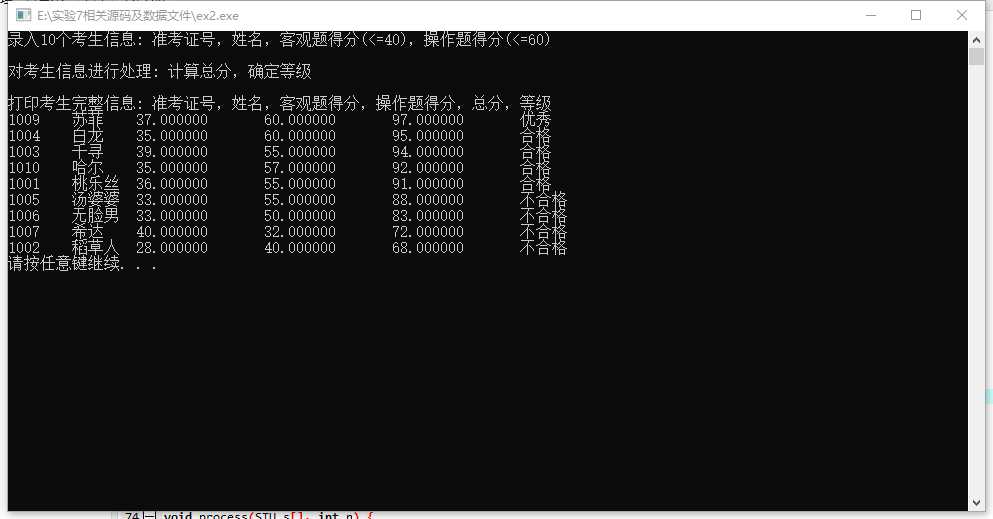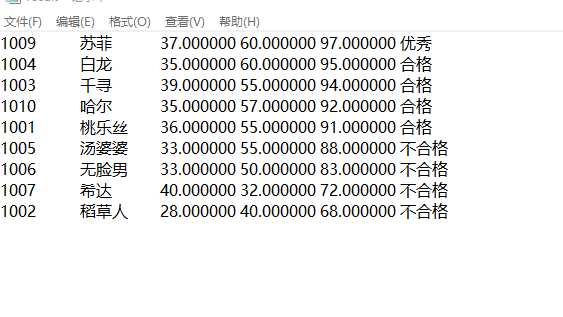标签:print ++ open can close time 合格 客观题 level
#include <stdio.h> #include <stdlib.h> #include <string.h> const int N = 10; // 定义结构体类型struct student,并定义其别名为STU typedef struct student { long int id; char name[20]; float objective; /*客观题得分*/ float subjective; /*操作题得分*/ float sum; char level[10]; }STU; // 函数声明 void input(STU s[], int n); void output(STU s[], int n); void process(STU s[], int n); int main() { STU stu[N]; printf("录入%d个考生信息: 准考证号,姓名,客观题得分(<=40),操作题得分(<=60)\n", N); input(stu, N); printf("\n对考生信息进行处理: 计算总分,确定等级\n"); process(stu, N); printf("\n打印考生完整信息: 准考证号,姓名,客观题得分,操作题得分,总分,等级\n"); output(stu, N); system("pause"); return 0; } // 从文本文件examinee.txt读入考生信息:准考证号,姓名,客观题得分,操作题得分 void input(STU s[], int n) { // 补足代码 // ××× FILE *fp1; int i; fp1=fopen("examinee.txt","r"); if(!fp1){ printf("fail to open examinee.txt\n"); exit(0); } for(i=0;i<N;i++){ fscanf(fp1,"%ld %s %f %f",&s[i].id,&s[i].name,&s[i].objective,&s[i].subjective); } fclose(fp1); } // 输出考生完整信息: 准考证号,姓名,客观题得分,操作题得分,总分,等级 // 不仅输出到屏幕上,还写到文本文件result.txt中 void output(STU s[], int n) { // 补足代码 // ××× FILE *fp2; int i; fp2=fopen("result.txt","w"); if(!fp2){ printf("fail to open result.txt\n"); exit(0); } for(i=0;i<n-1;i++){ printf("%ld\t%s\t%f\t%f\t%f\t%s\n",s[i].id,s[i].name,s[i].objective,s[i].subjective,s[i].sum,s[i].level); fprintf(fp2,"%ld\t%s\t%f\t%f\t%f\t%s\n",s[i].id,s[i].name,s[i].objective,s[i].subjective,s[i].sum,s[i].level); } fclose(fp2); } // 对考生信息进行处理:计算总分,排序,确定等级 void process(STU s[], int n) { // 补足代码 // ××× int h,i,j,k; STU temp; for(h=0;h<=n-1;h++) { s[h].sum = s[h].objective+s[h].subjective; } for(i=0;i<n-1;i++) { for(j=0;j<n-1-i;j++) { if(s[j].sum<s[j+1].sum) { temp = s[j]; s[j] = s[j+1]; s[j+1] = temp; } } } for(k=0;k<=n-1;k++) { if(k<=(n-1)*0.1) strcpy(s[k].level,"优秀"); else if(k>(n-1)*0.1&&k<=(n-1)*0.5) strcpy(s[k].level,"合格"); else strcpy(s[k].level,"不合格"); } }


标签:print ++ open can close time 合格 客观题 level
原文地址:https://www.cnblogs.com/m777/p/12114665.html